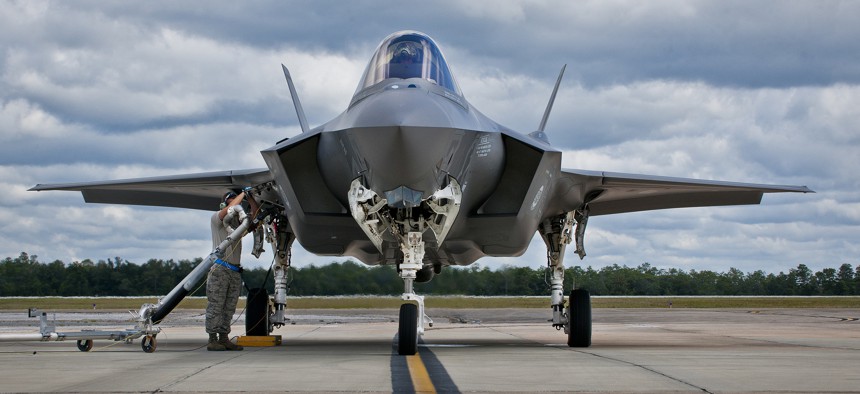
An F-35A is refueled at Eglin Air Force Base, Fla, on Sept. 26, 2014. U.S. Air Force photo by Samuel King Jr./Released
Pentagon Reconsidering Total F-35 Buy, Dunford Says
Gen. Joseph Dunford, the nominee for chairman of the Joint Chiefs of Staff, said he’s willing to rethink the acquisition plan for the most expensive weapons program ever.
Much has changed about the Pentagon’s Joint Strike Fighter program in the past 13 years, but one thing has remained steady: the number of F-35s to be bought for the Air Force, Navy and Marines.
All three variants have seen design tweaks, program managers have come and gone, and the projected price tag has climbed and climbed. Meanwhile, the world changed as well, while wars in Afghanistan and Iraq sucked money from long-term weapons projects. Through it all, Pentagon officials maintained they would need exactly 2,443 combat F-35s, plus 14 development aircraft, to deter and fight potential adversaries such as China.
But now radical extremists are wreaking havoc across much of the Middle East and northern Africa, and Russia has re-emerged as a major foe. On Thursday morning, Gen. Joseph Dunford, the Marine Corps commandant nominated to become the next chairman of the Joint Chiefs of Staff, told the Senate Armed Services Committee that the F-35 buying plan is under review.
“Given the evolving defense strategy and the latest Defense Planning Guidance, we are presently taking the newest strategic foundation and analyzing whether 2,443 aircraft is the correct number,” Dunford wrote in response to questions asked by the committee in advance of his hearing Thursday. “Until the analysis is complete, we need to pursue the current scheduled quantity buy to preclude creating an overall near-term tactical fighter shortfall.”
Dunford’s comments come one week after Army Gen. Martin Dempsey, the outgoing JCS chairman, warned in a new National Military Strategy that the military might need to rethink and reorganize for the hybrid wars of the future.
That doesn’t mean the F-35 — the largest weapons program ever, by many billions of dollars — is going away. “With projected adversarial threats challenging our current capabilities in coming years, the Joint Strike Fighter is a vital component of our effort to ensure the Joint Force maintains dominance in the air,” Dunford wrote.

The entire program, both developing and buying the actual jets, is projected to cost $400 billion, while operating and maintaining those planes is projected to cost between $859 billion and $1 trillion. In addition to the 2,457 U.S. aircraft, allies are projected to purchase hundreds of F-35s.
Many experts believed the Pentagon’s vision of a fleet of 2,443 Lockheed Martin F-35s was a pipe dream — but also that the program was likely stable for at least 15 to 20 years of its planned three-decade procurement period.
“I don’t think anybody on Wall Street would be surprised if [the Defense Department] starts to back away from that number just because I don’t think anybody really gave Lockheed Martin or the subcontractors on the program full credit for the total buy,” Byron Callan, a defense analyst with Capital Alpha Partners said.
“That said, we’re still probably going to get to a build rate of 150 [aircraft] per year total, at least for the early part of the decade,” he said. “Then the real question is what happens beyond that.”
After years of cost increases and schedule slips, the F-35 project has largely stabilized over the past three years, according to defense officials. The Marine Corps version of the jet will soon be declare battle-ready. In the coming years, the Pentagon is planning to increase its annual orders of the aircraft.
But while the F-35 program stretched out year by year, other strategic national-security priorities began appearing. At the end of the next decade, the Air Force is planning to buy new long-range stealth bombers, while the Navy plans to buy an expensive replacement for the Ohio-class submarine.
“If confirmed, I will advise the Secretary as he assesses the delicate balance of the capacity and the capabilities of the future Joint Force,” Dunford wrote. “This advice will be informed by the extent to which the F-35 program conforms to the priority requirements identified by Combatant Commanders and the Department’s strategic plans.”
While Dunford is the first senior-level defense official to acknowledge that the total F-35 buy could change, his comments are not likely to affect stocks or prompt companies to change their business plans, Callan said.
Lockheed shares were up $2.60 to $192.70 in late-day trading.




